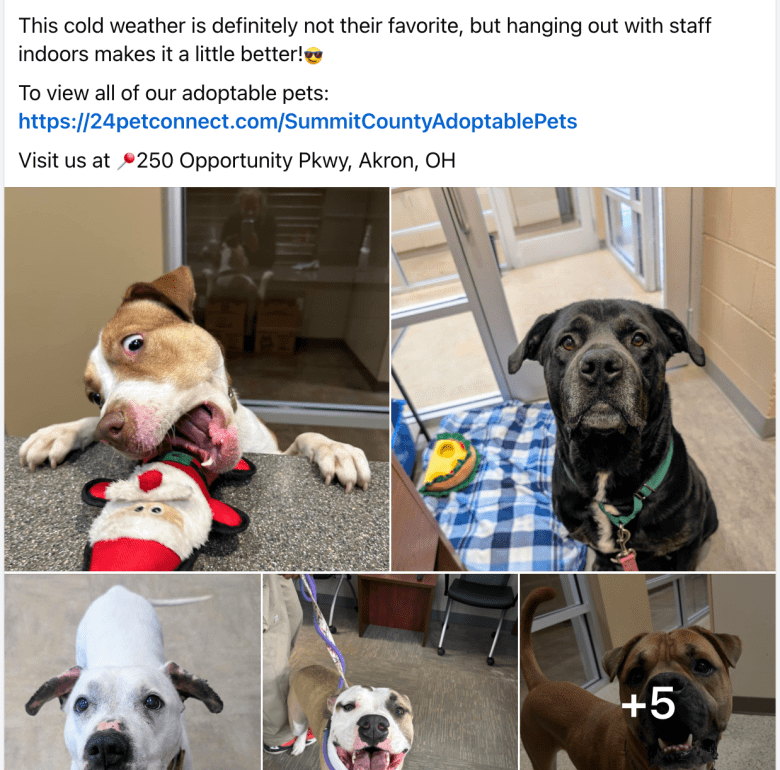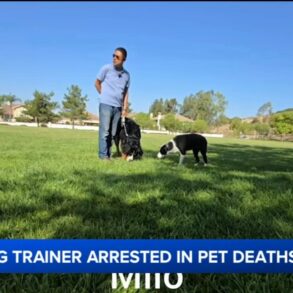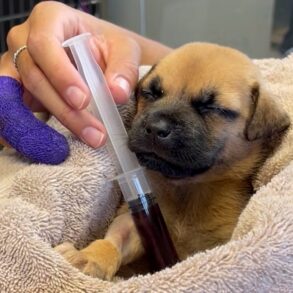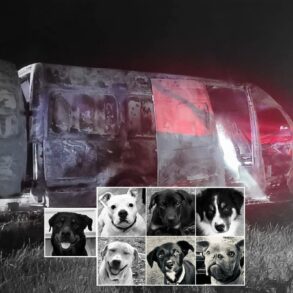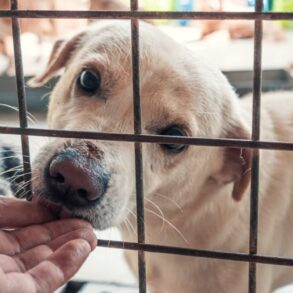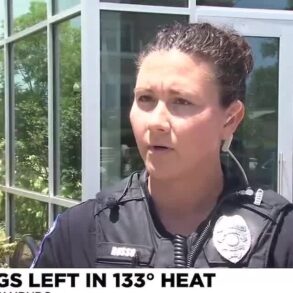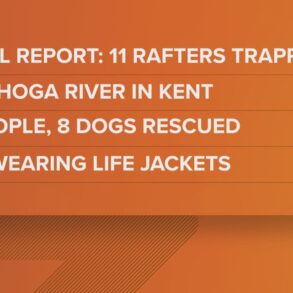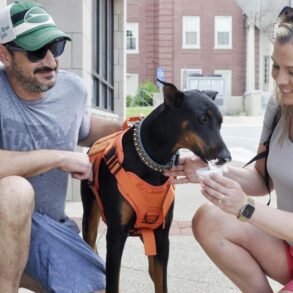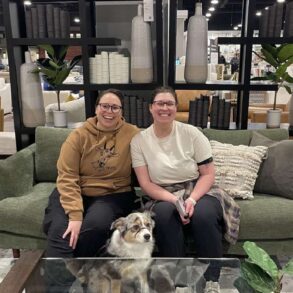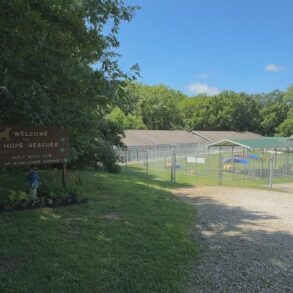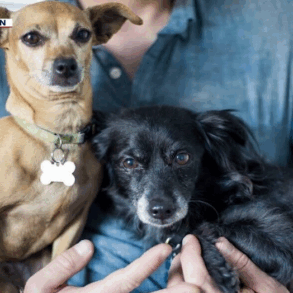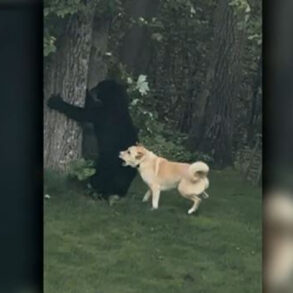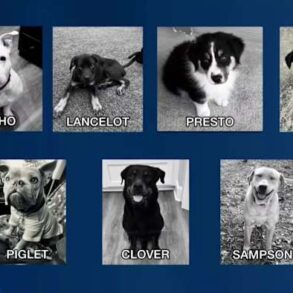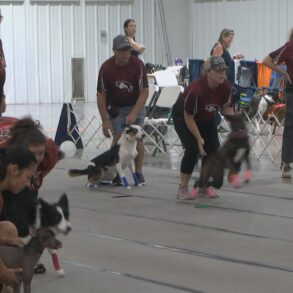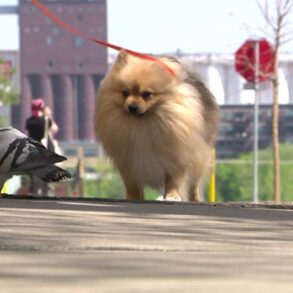“Enough’s enough. We have to fix this problem,” said Ward 7 Council Member Donnie Kammer at the Jan. 6 City Council meeting.
The issue? The county animal shelter is too full to accept more dogs and cats, and local animal rescue organizations don’t have enough resources to back up the shelter.
Kammer applauded (literally) the team behind Rubber City Rescue, an Akron nonprofit animal rescue organization whose vice president, Jason Johnson, spoke during public comment about the need for more facilities to hold stray animals in Akron.
The job done by local rescue groups is one he feels not everyone understands.
Kammer said he almost wanted the founder and president of RCR, Laura Lawson, who he has known since he was a child, to go on vacation for a month so that people could really see the problem at hand.
The issue? The county animal shelter is too full to accept more dogs and cats, and local animal rescue organizations don’t have enough resources to back up the shelter. (Screenshot via Akron City Council YouTube.)
” data-medium-file=”https://i0.wp.com/signalakron.org/wp-content/uploads/2025/01/Kammer_10625.jpg?fit=300%2C169&ssl=1″ data-large-file=”https://i0.wp.com/signalakron.org/wp-content/uploads/2025/01/Kammer_10625.jpg?fit=780%2C440&ssl=1″ src=”https://i0.wp.com/signalakron.org/wp-content/uploads/2025/01/Kammer_10625.jpg?resize=780%2C440&ssl=1″ alt=”Ward 7 Council Member Donnie Kammer ” class=”wp-image-37524″ srcset=”https://i0.wp.com/signalakron.org/wp-content/uploads/2025/01/Kammer_10625.jpg?resize=1024%2C578&ssl=1 1024w, https://i0.wp.com/signalakron.org/wp-content/uploads/2025/01/Kammer_10625.jpg?resize=300%2C169&ssl=1 300w, https://i0.wp.com/signalakron.org/wp-content/uploads/2025/01/Kammer_10625.jpg?resize=768%2C433&ssl=1 768w, https://i0.wp.com/signalakron.org/wp-content/uploads/2025/01/Kammer_10625.jpg?resize=1200%2C677&ssl=1 1200w, https://i0.wp.com/signalakron.org/wp-content/uploads/2025/01/Kammer_10625.jpg?resize=400%2C226&ssl=1 400w, https://i0.wp.com/signalakron.org/wp-content/uploads/2025/01/Kammer_10625.jpg?w=1500&ssl=1 1500w, https://i0.wp.com/signalakron.org/wp-content/uploads/2025/01/Kammer_10625-1024×578.jpg?w=370&ssl=1 370w” sizes=”(max-width: 780px) 100vw, 780px”>
“I don’t think there’s that many of us that would wake up at 2 o’clock, 3 o’clock, 4 o’clock in the morning to go rescue a dog,” Kammer said.
RCR works with the Akron police and fire departments daily to rescue animals. But with Summit County’s animal control department at capacity, RCR must turn away dogs, Johnson said during public comment.
Johnson asked the city to consider giving her rescue group a vacant building they could turn into an animal shelter that Summit County police departments could access.
“Let us move into it. Let us do the upkeep on it. Any repairs that need done, we’ll take care of that,” Johnson said.
Later in the meeting, Brittany Grimes Zaehringer, the city’s chief of staff, shared a status update on the issue.
” data-medium-file=”https://i0.wp.com/signalakron.org/wp-content/uploads/2025/01/brittany_GZ.jpg?fit=300%2C177&ssl=1″ data-large-file=”https://i0.wp.com/signalakron.org/wp-content/uploads/2025/01/brittany_GZ.jpg?fit=780%2C460&ssl=1″ src=”https://i0.wp.com/signalakron.org/wp-content/uploads/2025/01/brittany_GZ.jpg?resize=780%2C460&ssl=1″ alt=”Brittany Grimes Zaehringer, the City of Akron’s chief of staff.” class=”wp-image-37520″ srcset=”https://i0.wp.com/signalakron.org/wp-content/uploads/2025/01/brittany_GZ.jpg?resize=1024%2C604&ssl=1 1024w, https://i0.wp.com/signalakron.org/wp-content/uploads/2025/01/brittany_GZ.jpg?resize=300%2C177&ssl=1 300w, https://i0.wp.com/signalakron.org/wp-content/uploads/2025/01/brittany_GZ.jpg?resize=768%2C453&ssl=1 768w, https://i0.wp.com/signalakron.org/wp-content/uploads/2025/01/brittany_GZ.jpg?resize=1200%2C708&ssl=1 1200w, https://i0.wp.com/signalakron.org/wp-content/uploads/2025/01/brittany_GZ.jpg?resize=400%2C236&ssl=1 400w, https://i0.wp.com/signalakron.org/wp-content/uploads/2025/01/brittany_GZ.jpg?w=1500&ssl=1 1500w, https://i0.wp.com/signalakron.org/wp-content/uploads/2025/01/brittany_GZ-1024×604.jpg?w=370&ssl=1 370w” sizes=”(max-width: 780px) 100vw, 780px”>
The city has been working closely with Summit County and the Humane Society of Summit County (not a county agency) over the past two months, Zaehringer said, and has a few more meetings scheduled with them in the coming weeks. She said the issue is mostly a dog issue, including the number of animals that are in the shelters and the length of time that they’ve been there.
The administration is in the process of “scoping the root causes of the issues” and plans to engage with stakeholders of multiple perspectives, including rescue organizations, Zaehringer said in a statement sent to Signal Akron.
“Our goal is to identify and implement solutions that provide long-term answers to long-term problems. When we have actionable pathways, we will share more broadly,” Zaehringer said.
” data-image-caption data-medium-file=”https://i0.wp.com/signalakron.org/wp-content/uploads/2022/10/signal-bg-semi-transparent-40.png?fit=300%2C156&ssl=1″ data-large-file=”https://i0.wp.com/signalakron.org/wp-content/uploads/2022/10/signal-bg-semi-transparent-40.png?fit=780%2C404&ssl=1″ class=”wp-block-cover__image-background wp-image-2014″ alt=”Signal background” src=”https://i0.wp.com/signalakron.org/wp-content/uploads/2022/10/signal-bg-semi-transparent-40.png?resize=780%2C405&ssl=1″ data-object-fit=”cover” srcset=”https://i0.wp.com/signalakron.org/wp-content/uploads/2022/10/signal-bg-semi-transparent-40.png?w=2000&ssl=1 2000w, https://i0.wp.com/signalakron.org/wp-content/uploads/2022/10/signal-bg-semi-transparent-40.png?resize=300%2C156&ssl=1 300w, https://i0.wp.com/signalakron.org/wp-content/uploads/2022/10/signal-bg-semi-transparent-40.png?resize=1024%2C531&ssl=1 1024w, https://i0.wp.com/signalakron.org/wp-content/uploads/2022/10/signal-bg-semi-transparent-40.png?resize=768%2C399&ssl=1 768w, https://i0.wp.com/signalakron.org/wp-content/uploads/2022/10/signal-bg-semi-transparent-40.png?resize=1536%2C797&ssl=1 1536w, https://i0.wp.com/signalakron.org/wp-content/uploads/2022/10/signal-bg-semi-transparent-40.png?resize=1200%2C623&ssl=1 1200w, https://i0.wp.com/signalakron.org/wp-content/uploads/2022/10/signal-bg-semi-transparent-40.png?resize=1568%2C814&ssl=1 1568w, https://i0.wp.com/signalakron.org/wp-content/uploads/2022/10/signal-bg-semi-transparent-40.png?resize=400%2C208&ssl=1 400w, https://i0.wp.com/signalakron.org/wp-content/uploads/2022/10/signal-bg-semi-transparent-40.png?w=370&ssl=1 370w” sizes=”(max-width: 780px) 100vw, 780px”>
Summit County Animal Control does not have enough space for Akron’s dogs
There is some confusion about the ecosystem of animal care in Akron and exactly who is responsible for the care and keeping of an animal, said Greta Johnson, the director of communications for Summit County.
The Summit County Animal Control Department’s mission is to provide “compassionate care for impounded animals and responsible enforcement of canine laws, thereby creating a safer and more desirable community for the citizens of Summit County,” according to the website.
Services include adoption, dog licensing, euthanasia and reuniting missing pets with their owners.
It is not required to provide resources for surrendering dogs – pet owners looking to relinquish ownership cannot drop their dogs off at animal control.
“This, you know, lack of facilities or lack of resources for folks who want to surrender their dog, I acknowledge can be a problem, but that is not the mission or the obligation of Summit County Animal Control,” Johnson said.
The mission, as required by law, is to address stray dogs found in the townships within Summit County, Johnson said. The City of Akron has a contract with Summit County. The terms say that the county will accept Akron’s strays until the shelter is full.
And the SCACD is not statutorily or contractually obligated to accept cats.
When residents call 311 — or call the Akron warden directly at 330-375-2320 — to report an animal, the animal control department’s wardens will respond to the call. The warden also assists with requests from the police department.
But the department has a capacity issue.
Despite adopting out 602 dogs and 656 cats and reuniting 199 dogs and four cats with their owners in 2024, the kennel is still full. There is only space for 92 to 98 dogs, Johnson said. And that tends to fill up quickly.
According to its site, the SCACD “practices euthanasia in an effort to protect the health, safety and general well being of citizens and control the local animal population,” but there is no stated policy about euthanizing animals for space.
“It has been an ongoing issue, off and on, at Animal Control being at capacity for the better part of a decade,” Johnson said. “But we’ve really seen an increase, frankly, post-pandemic.”
Johnson said that people who wanted companionship at the onset of the pandemic perhaps did not understand the full commitment of having a pet.
And the Humane Society of Summit County, which the city is meeting with to find a solution, is also operating at full capacity and is unable to accept owner surrenders unless the animal was previously adopted from them. They can still accept stray animals that are severely sick or injured and animals seized in pending abuse and neglect charges.
” data-medium-file=”https://i0.wp.com/signalakron.org/wp-content/uploads/2025/01/rescue012325be-1.jpg?fit=300%2C196&ssl=1″ data-large-file=”https://i0.wp.com/signalakron.org/wp-content/uploads/2025/01/rescue012325be-1.jpg?fit=780%2C510&ssl=1″ src=”https://i0.wp.com/signalakron.org/wp-content/uploads/2025/01/rescue012325be-1.jpg?resize=780%2C510&ssl=1″ alt=”Rubbet City Rescue is an Akron-based nonprofit.” class=”wp-image-37696″ srcset=”https://i0.wp.com/signalakron.org/wp-content/uploads/2025/01/rescue012325be-1.jpg?resize=1024%2C670&ssl=1 1024w, https://i0.wp.com/signalakron.org/wp-content/uploads/2025/01/rescue012325be-1.jpg?resize=300%2C196&ssl=1 300w, https://i0.wp.com/signalakron.org/wp-content/uploads/2025/01/rescue012325be-1.jpg?resize=768%2C503&ssl=1 768w, https://i0.wp.com/signalakron.org/wp-content/uploads/2025/01/rescue012325be-1.jpg?resize=1200%2C786&ssl=1 1200w, https://i0.wp.com/signalakron.org/wp-content/uploads/2025/01/rescue012325be-1.jpg?resize=400%2C262&ssl=1 400w, https://i0.wp.com/signalakron.org/wp-content/uploads/2025/01/rescue012325be-1.jpg?w=1500&ssl=1 1500w, https://i0.wp.com/signalakron.org/wp-content/uploads/2025/01/rescue012325be-1-1024×670.jpg?w=370&ssl=1 370w” sizes=”(max-width: 780px) 100vw, 780px”>
‘Homegrown’ animal rescue organization has stepped in to assist county
When the SCACD and Humane Society kennels are at capacity and cannot fulfill a call for a stray animal pickup, local animal rescue organizations, like RCR, try to fill the gaps.
Just this month, Lawson got a call around midnight from Akron police, who needed a place to kennel a stray pit bull they picked up.
The local nonprofit not only picks up stray dogs that may potentially be dangerous but also reunites lost pets and takes care of sick or injured animals before attempting to adopt them out. Finding homes for the animals is one of the best parts of Lawson’s job.
“It’s really fulfilling, especially when you get them home, …” Lawson said. “I tell people all the time, we’re fixing broken hearts one pet at a time.”
Lawson founded RCR in 2015, a few years after her dog, Nico, was stolen and she joined local lost-and-found groups in hopes of finding him. She was reunited with the Siberian Husky and began working with the organizations.
Lawson’s group works to address the issues in Akron specifically, although she also answers calls from across the county.
“I am homegrown, and I plan to stay that way,” Lawson said.
” data-medium-file=”https://i0.wp.com/signalakron.org/wp-content/uploads/2025/01/rescue012325A-1.jpg?fit=300%2C200&ssl=1″ data-large-file=”https://i0.wp.com/signalakron.org/wp-content/uploads/2025/01/rescue012325A-1.jpg?fit=780%2C520&ssl=1″ src=”https://i0.wp.com/signalakron.org/wp-content/uploads/2025/01/rescue012325A-1.jpg?resize=780%2C520&ssl=1″ alt=”Laura Lawson and Jason Johnson of Rubber City Rescue.” class=”wp-image-37699″ srcset=”https://i0.wp.com/signalakron.org/wp-content/uploads/2025/01/rescue012325A-1.jpg?resize=1024%2C683&ssl=1 1024w, https://i0.wp.com/signalakron.org/wp-content/uploads/2025/01/rescue012325A-1.jpg?resize=300%2C200&ssl=1 300w, https://i0.wp.com/signalakron.org/wp-content/uploads/2025/01/rescue012325A-1.jpg?resize=768%2C512&ssl=1 768w, https://i0.wp.com/signalakron.org/wp-content/uploads/2025/01/rescue012325A-1.jpg?resize=1200%2C800&ssl=1 1200w, https://i0.wp.com/signalakron.org/wp-content/uploads/2025/01/rescue012325A-1.jpg?resize=400%2C267&ssl=1 400w, https://i0.wp.com/signalakron.org/wp-content/uploads/2025/01/rescue012325A-1.jpg?w=1500&ssl=1 1500w, https://i0.wp.com/signalakron.org/wp-content/uploads/2025/01/rescue012325A-1-1024×683.jpg?w=370&ssl=1 370w” sizes=”(max-width: 780px) 100vw, 780px”>
Local rescuers pay out of pocket to care for strays
When Lawson was initially looking to add a kennel to her backyard, the permit was held up with City Council for over a year because it wanted to make sure there were safety measures in place, Kammer told Signal Akron. Eventually, Kammer became frustrated with the lack of progress and pushed to move the legislation forward.
And the endeavor is costly.
For the animals that Lawson and her team handle, there is the cost of food and medical care — as well as the cost of paying a private kennel, or a fellow rescuer, to take care of the animals when she doesn’t have space for them on her property.
As a nonprofit, RCR is funded by grants and donations (anyone looking to donate can send money through Cashapp to @rubbercityrescue), and out of Lawson’s pocket.
“Rescue is a great thing if you do it right. If you’re in it to make money, then you’re in it for the wrong reasons,” Lawson said. “You either break even or you go broke, but you’re saving a lot of lives in the end.”
Kammer said that he has used funds from the Neighborhood Partnership Grant Program to support RCR over the years, but he wants to find a more permanent solution, so the grant funds can be used for other projects as well.
Because of liability issues, Kammer said he can’t support the request to find a vacant building for the rescue operation to use, at least for now.
” data-medium-file=”https://i0.wp.com/signalakron.org/wp-content/uploads/2025/01/rescue012325c-1.jpg?fit=300%2C200&ssl=1″ data-large-file=”https://i0.wp.com/signalakron.org/wp-content/uploads/2025/01/rescue012325c-1.jpg?fit=780%2C519&ssl=1″ src=”https://i0.wp.com/signalakron.org/wp-content/uploads/2025/01/rescue012325c-1.jpg?resize=780%2C519&ssl=1″ alt=”Laura Lawson of Rubber City Rescue.” class=”wp-image-37697″ srcset=”https://i0.wp.com/signalakron.org/wp-content/uploads/2025/01/rescue012325c-1.jpg?resize=1024%2C681&ssl=1 1024w, https://i0.wp.com/signalakron.org/wp-content/uploads/2025/01/rescue012325c-1.jpg?resize=300%2C200&ssl=1 300w, https://i0.wp.com/signalakron.org/wp-content/uploads/2025/01/rescue012325c-1.jpg?resize=768%2C511&ssl=1 768w, https://i0.wp.com/signalakron.org/wp-content/uploads/2025/01/rescue012325c-1.jpg?resize=1200%2C798&ssl=1 1200w, https://i0.wp.com/signalakron.org/wp-content/uploads/2025/01/rescue012325c-1.jpg?resize=400%2C266&ssl=1 400w, https://i0.wp.com/signalakron.org/wp-content/uploads/2025/01/rescue012325c-1.jpg?w=1500&ssl=1 1500w, https://i0.wp.com/signalakron.org/wp-content/uploads/2025/01/rescue012325c-1-1024×681.jpg?w=370&ssl=1 370w” sizes=”(max-width: 780px) 100vw, 780px”>
Akron’s dog laws make it ‘challenging’ to adopt pets from animal control, Summit County official say
Johnson, from Summit County, said that more than 95% of the dogs in the animal control facility are from Akron, and almost 100% of the dogs are pit bulls, or pit bull mixed breeds. But with the City of Akron’s guidelines for dog ownership, Akronites cannot come back and adopt these animals.
The City of Akron has requirements for dog owners of certain breeds — American bulldogs, canary dogs and pit bulls — that include restrictions for taking the dog out in public (they must be leashed and muzzled) as well as specific tags and collars. These dog breeds are also required to be tattooed with an identification number. Each requirement comes with a fee, including licensing the dogs, which costs $18 per year or $180 for a lifetime license.
The ordinances “make it particularly challenging to own, legally, a pit bull or a pit bull mix in the city,” Johnson said. “It can pose some financial and logistical issues too that make adopting these dogs, make it tough.”
The law, in theory, allows the city to hold dog owners liable if their pet causes, or attempts to cause, harm to another person, animal or property. The requirements to tag and tattoo the dogs also allow rescue operations to trace an animal back to its owner.
Lawson said it’s not a dog problem but a people problem — for example, owners who abandon potentially dangerous dogs, which can have harmful consequences.
Local animal rescuer was attacked on the job, hospitalized
In September, Lawson responded to a call to pick up a female pit bull that had been left in an apartment.
When she loaded the dog into her van, Lawson felt uneasy about her behavior. The dog had what she calls the “bug eye” — which she said is a sign of aggression. So Lawson moved her to a cage in the back of the vehicle.
When Lawson went to unload the pit bull at home, the dog caught sight of a cat at the residence and heard the other dogs barking in their outdoor cubbies and went “ballistic,” Lawson said.
Lawson and her husband decided to move the dog to the backyard kennel, where there were no other dogs at the time. As Lawson tried to shut the door on the cage, the dog launched at Lawson. Her husband had to fight the dog off of her.
Lawson was hospitalized. She sustained injuries to her face, chest and right arm, and she was left with medical bills to pay.
And she had to keep the dog in her possession for five more days until the dog was reunited with its owner. The SCACD and the Humane Society would not take the dog, and Lawson said it would “be on her” if she let the dog go and it attacked another person.
In the days after the attack, the dog, caged, would come “unglued” and try to attack her,
“It got to the point that I had to pay somebody to come over and take care of the kennels every day for me, because I couldn’t go in there,” Lawson said.
After Lawson was attacked, Kammer asked City Council to pay her medical bills.
The response from the city’s administration was, Kammer said, “We’re not liable. We’re not responsible for taking care of her bills or nothing. She does this on her own and as a volunteer.”
“‘Well, stop using her then. Quit using her,’ I said. Because it’s not fair,” Kammer said.
Kammer said that he has a soft spot for animals and that the city is “using and abusing” Lawson by not compensating her and finding ways to collaborate. He said he is totally on board to contract with her to work for the city.
“She just has a heart of gold,” Kammer said.
This post was originally published on this site be sure to check out more of their content.




